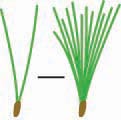













Edited by Sandy Livoti and Dan Downing
Cover, book design and leaf illustrations by Jonathan Norberg
Tree illustrations by Julie Martinez
Cover photo: Ohio Buckeye by Stan Tekiela
All photos copyright by Stan Tekiela unless otherwise noted.
Steven J. Baskauf: (fruit)
*Dembinsky Photo Associates
The following Bugwood (weedimages.org) images below are licensed under the Creative Commons Attribution 3.0 (CC BY 3.0 US) License.
Franklin Bonner/USFS: (corky bark).
Images used under license from Shutterstock.com:
John De Winter: (flower).
10 9 8 7 6 5 4 3 2 1
Trees of Ohio Field Guide
First Edition 2004
Second Edition 2021
Copyright 2004 and 2021 by Stan Tekiela
Published by Adventure Publications
An imprint of AdventureKEEN
310 Garfield Street South
Cambridge, Minnesota 55008
(800) 678-7006
www.adventurepublications.net
All rights reserved
Printed in China
ISBN 978-1-64755-094-3 (pbk.), 978-1-64755-095-0 (ebook)
TABLE OF CONTENTS
OHIO AND TREES
Ohio is a great place for anyone interested in trees. With Trees of Ohio Field Guide , youll be able to quickly identify 115 of the most common trees in Ohionearly all of which are native to the state. This guide also includes a number of common non-native trees that have been naturalized in Ohio. This author makes no attempt to identify cultivated or nursery trees.
Because this book is a unique, all-photographic guide just for Ohio, you wont have to page through photographs of trees that dont grow in the state, or attempt to identify live trees by studying black-and-white line drawings.
WHAT IS A TREE?
For the purposes of this book, a tree is defined as a large woody perennial plant, usually with a single erect trunk, standing at least 15 feet (4.5 m) tall, with a well-defined crown. Trees of Ohio Field Guide helps you observe some basic characteristics of trees so you can identify different species confidently.
HOW THIS BOOK IS ORGANIZED
To identify a tree, youll want to start by looking at the thumb tab in the upper right-hand corner of the text pages. These thumb tabs define the sections of the book. The tab combines several identifying features of a treemain category, needle or leaf type and attachmentinto one icon.
Its possible to identify trees using this field guide without learning about categories, leaf types and attachments. Simply flip through the pages to match your sample to the features depicted on the thumb tabs. Once you find the correct section, use the photos to find your tree. Or, you may want to learn more about the features of trees in a methodical way, using the following steps to narrow your choices to just a few photos.
First, determine the appropriate section and find the right icon by asking these questions: Is the tree coniferous or deciduous? If it is a conifer, are the needles single, clustered or scaly? If it is deciduous, is the leaf type simple, lobed or compound, and do leaves attach to twigs in an opposite or alternate pattern?
Next, simply browse through the photos in that section to find your tree. Or, to further narrow your choices, use the icon in the lower right-hand corner of the text pages. These icons are grouped by the general shape of the needle or leaf, and they increase in size as the average size of the needle or leaf increases.
Finally, by examining the full-page photos of needles or leaves, studying the inset photos of bark, flowers, fruit or other special features and considering information on text pages, you should be able to confidently identify the tree.
While these steps briefly summarize how you can use this book, it is quite helpful to learn more about how the sections are grouped by reading the Identification Step-by-Step section.
IDENTIFICATION STEP-BY-STEP
Conifer or Deciduous
Trees in this field guide are first grouped into two main categories that consist of 16 conifers and 99 deciduous trees.
Trees with evergreen needles that remain on branches year-round and have seeds in cones are conifers. Some examples of these are pines and spruces. The exceptions in this main category are the Bald Cypress and the Tamarack, conifers that behave like deciduous trees, shedding their needles in autumn. Trees with broad, flat leaves that fall off their branches each autumn are deciduous. Some examples of these are oaks and maples.
You will see by looking at the thumb tabs that trees with needles (conifers) are shown in the first sections of the book, followed by trees with leaves (deciduous).
Needle or Leaf Type
Conifer Group:
Single, Clustered or Scaly Needles

SINGLE

CLUSTERED
(Range of 230 needles)

SCALY
If the tree is a conifer, the next step is to distinguish among single, clustered and scaly needles. Begin by checking the number of needles that arise from one point. If you see only one needle arising from one point, look in the single needle section. Conifers with single needles are shown first. If there are at least two needles arising from one point, turn to the clustered needles section. This second section is organized by the number of needles in a cluster. If you are trying to identify needles that overlap each other and have a scale-like appearance, unlike the other needles, you will find this type in the scaly needles section.
Next page
































